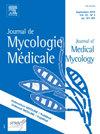hiv感染者骨髓隐球菌病1例报告并文献复习
IF 1.8
4区 医学
Q3 MYCOLOGY
引用次数: 0
摘要
背景与目的隐球菌病是免疫功能低下人群中常见的机会性真菌感染。通常从脑脊液、痰液或皮肤病变中分离。然而,弥散性隐球菌病累及骨髓是极为罕见的。病例报告:该病例描述了一名34岁男性HIV感染者,出现发烧、腹痛和全血细胞减少症。诊断评估,包括骨髓穿刺和活检,发现包膜酵母与隐球菌一致。尽管血液和脑脊液培养未能识别真菌,但确诊为分离性骨髓隐球菌病。对21例先前报告的病例(截至2024年10月)进行了文献回顾,发现免疫功能低下患者占主导地位,男性患者更常受到影响。细胞减少症是所有病例的共同发现,骨髓活检是诊断的必要条件。治疗方案仍未标准化。结论骨髓隐球菌病虽然罕见,但在免疫功能低下患者,特别是HIV感染者全血细胞减少症的鉴别诊断中应予以考虑。本文章由计算机程序翻译,如有差异,请以英文原文为准。
Bone marrow cryptococcosis in an HIV-infected patient: A case report and literature review
Background and Purpose
Cryptococcosis is a common opportunistic fungal infection in immunocompromised individuals. It is typically isolated from cerebrospinal fluid, sputum, or skin lesions. However, disseminated cryptococcosis involving the bone marrow is an extremely rare occurrence.
Case Report
This case describes a 34-year-old male patient living with HIV who developed fever, abdominal pain, and pancytopenia. Diagnostic evaluation, including bone marrow aspiration and biopsy, revealed encapsulated yeasts consistent with Cryptococcus sp. Although blood and cerebrospinal fluid cultures failed to identify fungal agents, the diagnosis of isolated bone marrow cryptococcosis was confirmed. A literature review of 21 previously reported cases (up to October 2024) was conducted, revealing a predominance of immunocompromised patients, with male patients being more frequently affected. Cytopenia was a common finding in all cases, and bone marrow biopsy was essential for diagnosis. Treatment protocols remain unstandardized.
Conclusion
Bone marrow cryptococcosis, while rare, should be considered in the differential diagnosis of pancytopenia in immunocompromised patients, particularly those with HIV.
求助全文
通过发布文献求助,成功后即可免费获取论文全文。
去求助
来源期刊
CiteScore
5.10
自引率
2.80%
发文量
68
审稿时长
6-12 weeks
期刊介绍:
The Journal de Mycologie Medicale / Journal of Medical Mycology (JMM) publishes in English works dealing with human and animal mycology. The subjects treated are focused in particular on clinical, diagnostic, epidemiological, immunological, medical, pathological, preventive or therapeutic aspects of mycoses. Also covered are basic aspects linked primarily with morphology (electronic and photonic microscopy), physiology, biochemistry, cellular and molecular biology, immunochemistry, genetics, taxonomy or phylogeny of pathogenic or opportunistic fungi and actinomycetes in humans or animals. Studies of natural products showing inhibitory activity against pathogenic fungi cannot be considered without chemical characterization and identification of the compounds responsible for the inhibitory activity.
JMM publishes (guest) editorials, original articles, reviews (and minireviews), case reports, technical notes, letters to the editor and information. Only clinical cases with real originality (new species, new clinical present action, new geographical localization, etc.), and fully documented (identification methods, results, etc.), will be considered.
Under no circumstances does the journal guarantee publication before the editorial board makes its final decision.
The journal is indexed in the main international databases and is accessible worldwide through the ScienceDirect and ClinicalKey platforms.

 求助内容:
求助内容: 应助结果提醒方式:
应助结果提醒方式:


